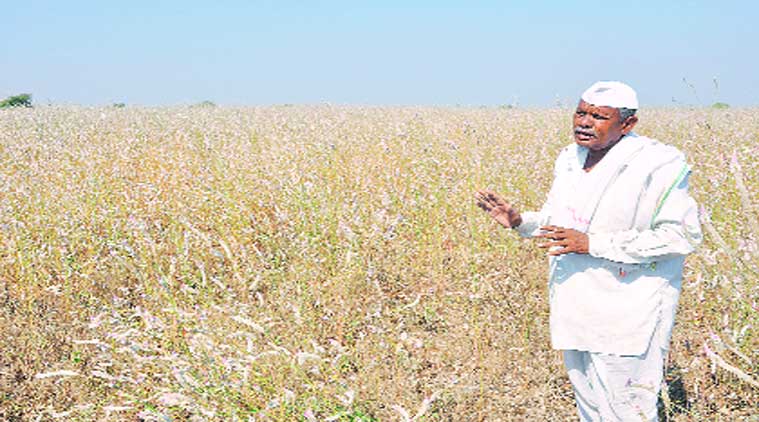- India
- International
From drought zone: Despite rainfall, Vidarbha farmers left high & dry
Mismatch between crop and rainfall time-tables, poor irrigation and power supply leads to severe drought
 Sampatrao Jadhav at his farm in Jahangir village of Washim district. (Source: Express photo by Deepak Dawre)
Sampatrao Jadhav at his farm in Jahangir village of Washim district. (Source: Express photo by Deepak Dawre)
A T Dhotra (Jahangir) village in Washim’s Karanja (Lad) tehsil, 61-year old Sampatrao Jadhav is just whiling away time in his three-acre farm. Standing disoriented amidst wild growth of komba weed topped with white corns lording over the stunted soyabean plants, he desolately looks around and fiddles with the legumes, tweaking the jowar-sized grains with his fingers. While others have broken down the crop and cleaned up their farms, Jadhav is left with no interest even to clean up his farm of the crop that is gone.
“In these three acres, I took about 25 quintals last year. This time, the loss is 100 per cent despite two sowings. What should I do,” he asks.
At Kamargaon village, widow Alka Shankarrao Lakde appears to keep her cool despite the double blow of her husband’s suicide on September 2 due to debt burden and the total loss of crop on 1.62 hectares of land. She knows that like all other widows of farmers, she must struggle to feed her two sons and a daughter. “I will have to work as farm labourer now,” she says.
However, not many in this area are ready to work for wages in others’ farms or take up MNREGS works, unlike in the neighbouring Marathwada. Muster records at Dhotra show poor response to calls by government to take up work in times of distress.
Farmers insist MNREGS is just a stop-gap solution and no substitute for what they deserve, which is a better price for their produce, irrigation and uninterrupted power supply.

With less than 20 per cent overall annual irrigation potential and power supply not lasting over six hours a day, they can hardly be blamed.
For the first time ever, yields in the entire division have gone down by over 64 per cent, according to Agriculture Department surveys. The government has declared all 7,350 villages having about 17 lakh farmers drought-hit. Across all five districts of Amravati, Washim, Akola, Yavatmal and Buldana, dead soyabean and pulses (moong, udid) crops can be seen along hundreds of kilometres on both sides of any road taken. Many have cut it down and collected as kutaar (animal feed) in their forests.
“We haven’t seen this kind of drought before, It’s worse than 1971,” is the common refrain.
People say, “It didn’t rain when the soyabean legumes were developing grains. So, the grains remained of the size of jowar.”
Interestingly, the drought here is more because of a mismatch between crop and rainfall time-tables. The region received about 78 per cent of the average rainfall and is unlikely to experience water crunch in the coming days since last year’s excessive rainfall has helped in water storage being reasonably good, standing at 74 per cent today.
Also, erratic BSNL mobile network has affected the delivery of weather bulletins and SMS weather alerts.
“It’s an agricultural, not hydrological drought,” says Divisional Commissioner Dnyaneshwar Rajurkar.
Soyabean, which accounts for 50 per cent of the cultivated area, has been worst hit across the division, followed by cotton (30 per cent of the total area) and tuar (12 per cent).
Among all, Washim is the only district in Vidarbha that grows soyabean on over 85 per cent of the cultivable area, the remaining being cotton and pulse (tuar). Its paisewari (yield in percentage terms compared to last ten year’s average) of less than 38 is lowest in many decades.
In the neighbouring Buldana district, Lonar tahsil, which boasts of world-famous meteor crater, stares at an unprecedented loss caused by the double blow of massive hailstorm in March and now of the drought. Bhagwan Ghuge from Pahur village says he and and his four brothers together have fetched only four quintals from 11 acres.
The world of farm widow Shantabai Ghuge, whose husband committed suicide two days after the March hailstorm, has come crashing down after the disastrous kharif that hit her months later.
Most others in the region claim they haven’t reaped more than a bag (one quintal) per acre, which should be 7-8 bags in a normal year.
Adding to their woes is the fallen prices of the commodities. Cotton is down to less than Rs 4,000 from last year’s Rs 5,000-plus while soyabean is down to about Rs 2,500 from the 2013 peak of Rs 4,000.
“Many in our area have postponed marriages in the family,” says Maroti More, aarpanch of Dabha village, citing example of Dadarao More, who has put off his daughter’s marriage.
“We have 62 wells in the village, but there is no electricity. So, we can’t use whatever water is available to us,” Ghuge says.
Maharashtra State Electricity Distribution Company Limited is termed by people as the biggest villain.
Amravati Deputy Commissioner (Revenue) Ravindra Thakre concedes that there is a huge agricultural pump energisation backlog. “We have 38,862 applications pending cumulatively since 2011-12,” he says. “That’s a setback since we have constructed thousands of wells across the region under Dhadak Vihir Yojaya over the past few years, but the effective utility is nil if there is no power,” he adds.
He also points out that the crisis is set to continue into the rabi season with only 26 per cent of the average rabi area (5.92 lakh hectares) expected to be sown this time. “Though we have good storage, moisture in soil is less. So, rabi scene is also not very encouraging,” Thakre says.
Cotton too, despite being a drought-resistant crop, is badly hit in many parts. At Marwadi village in Yavatmal’s Pusad tahsil, Gangaprasad Murai shows his four-acre plot that is green with cotton plants with no bolls. “All this is virtually gone. I have picked four quintals so far, which is what I normally get in an acre,” he says.
His uncle Santosh Murai, a progressive farmer, had adopted high-density sowing technique supported by Nuziveedu seed company and also had irrigation. He is reaping the benefits, yielding 10 quintal per acres.
“But same can’t be true of every farmer in the 40 villages in this dreary malpathar (dry upland). We are surrounded by three dams, but have no water since this part is uppishly situated. Farmers here need solid government support,” he says.
The official cotton loss estimates are not yet out. But they are unlikely to be good enough to bring any relief.
“We want 100 per cent compensation, not part damages,” villagers say in unison.
Farm activist Gajanan Ahmedabadkar says: “The farmer mostly reaps either as much as he sows in terms of money or less. Rarely does he gets a bumper crop. And the government’s support price is less than even then production cost. So, what’s wrong if he expects full damages.”
Chief Minister Devendra Fadnavis is already feeling the heat of discontent. After taking stock of the situation in the division at Amravati on November 28, he directed the officials to see to it that the rabi area goes up to the maximum extent possible since water is available for crops. “He also directed the electricity officials to improve supply by replacing the 450 defunct transformers within 15 days. For stuck-up irrigation projects, he has given officials three-year time-bound completion directives,” said a senior official.
About 2,000 villages hit in Nagpur division
The paddy-dominated Nagpur revenue division comprising six districts of Wardha, Nagpur, Chandrapur, Bhandara, Gondia and Gadchiroli is relatively better placed, with only 2,000 of the total over 8,000 villages having less than 50 per cent paisewari. “There are mainly in the cotton and soyabean-growing areas of Wardha (over 1,000), Nagpur (over 500) and Chandrapur (over 400) with the main affected crop being soyabean,” said Deputy Commissioner (Revenue) Parag Dange.
Apr 26: Latest News
- 01
- 02
- 03
- 04
- 05








































